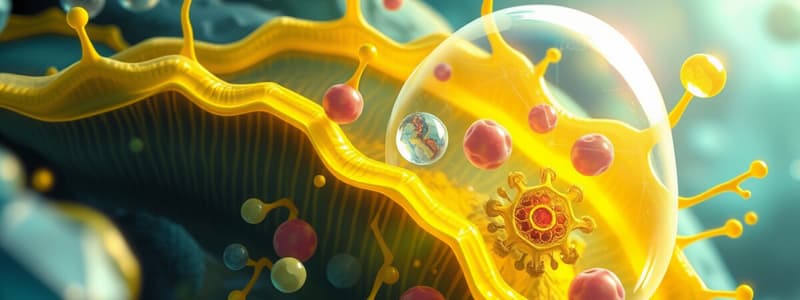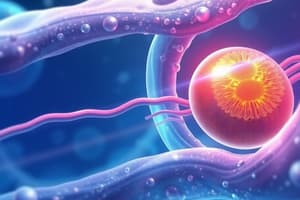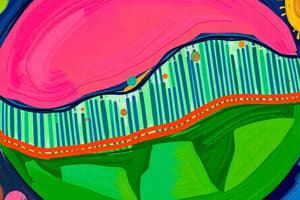Podcast
Questions and Answers
What type of transport requires energy to move substances across the membrane?
What type of transport requires energy to move substances across the membrane?
- Facilitated diffusion
- Passive transport
- Active transport (correct)
- Simple diffusion
Which term describes the movement of water through a semipermeable membrane?
Which term describes the movement of water through a semipermeable membrane?
- Osmoregulation
- Diffusion
- Filtration
- Osmosis (correct)
What is the state of two solutions that have the same concentration of solutes?
What is the state of two solutions that have the same concentration of solutes?
- Isosmotic (correct)
- Hyperosmotic
- Hypoosmotic
- Concentrated
What does the concentration gradient refer to in the context of molecular movement?
What does the concentration gradient refer to in the context of molecular movement?
What characterizes a hyperosmotic solution?
What characterizes a hyperosmotic solution?
What is the primary function of the Golgi apparatus?
What is the primary function of the Golgi apparatus?
What role do mitochondria play in the cell?
What role do mitochondria play in the cell?
Which cellular structure is primarily responsible for maintaining the cell's shape?
Which cellular structure is primarily responsible for maintaining the cell's shape?
Which type of cellular structure is primarily involved in movement across the cell surface?
Which type of cellular structure is primarily involved in movement across the cell surface?
What are the two main types of lipid bilayers found in mitochondria?
What are the two main types of lipid bilayers found in mitochondria?
Which filament type is NOT typically found in the cytoskeleton?
Which filament type is NOT typically found in the cytoskeleton?
What function is unique to flagella in human cells?
What function is unique to flagella in human cells?
Which structure in the cell is not involved in energy production?
Which structure in the cell is not involved in energy production?
What is the primary function of the cell membrane?
What is the primary function of the cell membrane?
What are the two main types of extracellular fluid mentioned?
What are the two main types of extracellular fluid mentioned?
What role do membrane proteins play?
What role do membrane proteins play?
How do lipid bilayers contribute to membrane fluidity?
How do lipid bilayers contribute to membrane fluidity?
Which process describes the conversion of DNA into RNA?
Which process describes the conversion of DNA into RNA?
What is one characteristic of the organelles involved in energy production?
What is one characteristic of the organelles involved in energy production?
Which of the following describes interstitial fluid?
Which of the following describes interstitial fluid?
What is a major barrier to the diffusion of polar molecules across the cell membrane?
What is a major barrier to the diffusion of polar molecules across the cell membrane?
What is the primary function of microvilli on the surface of cells?
What is the primary function of microvilli on the surface of cells?
Which component is responsible for manufacturing RNA needed for ribosome construction?
Which component is responsible for manufacturing RNA needed for ribosome construction?
What determines the genetic code in a gene?
What determines the genetic code in a gene?
During transcription, what is produced after the complementary strands of DNA are separated?
During transcription, what is produced after the complementary strands of DNA are separated?
What role does tRNA play during translation?
What role does tRNA play during translation?
What happens to pre-mRNA before it is transformed into mature mRNA?
What happens to pre-mRNA before it is transformed into mature mRNA?
What type of cells do not undergo cell replication?
What type of cells do not undergo cell replication?
What indicates the end of the translation process?
What indicates the end of the translation process?
Which stage of DNA replication involves adding correct bases to the template strand?
Which stage of DNA replication involves adding correct bases to the template strand?
How many chromosomes are found in somatic cells?
How many chromosomes are found in somatic cells?
What component is NOT part of the cell cycle?
What component is NOT part of the cell cycle?
What is the role of the spliceosomes during RNA processing?
What is the role of the spliceosomes during RNA processing?
What type of RNA carries the genetic information from DNA to the ribosome for protein synthesis?
What type of RNA carries the genetic information from DNA to the ribosome for protein synthesis?
Which of the following statements about histones is true?
Which of the following statements about histones is true?
What phase of the cell cycle does replication of DNA occur?
What phase of the cell cycle does replication of DNA occur?
During which stage of mitosis do sister chromatids align at the cell's equator?
During which stage of mitosis do sister chromatids align at the cell's equator?
What is the function of the centromere during cell division?
What is the function of the centromere during cell division?
What structure forms during cytokinesis to aid in cell separation?
What structure forms during cytokinesis to aid in cell separation?
Which type of cell division results in cells containing half the original amount of DNA?
Which type of cell division results in cells containing half the original amount of DNA?
What happens during the G1 phase of interphase?
What happens during the G1 phase of interphase?
What is the main purpose of contact inhibition?
What is the main purpose of contact inhibition?
Which of the following is true about stem cells?
Which of the following is true about stem cells?
What primarily drives the movement of chromosomes during anaphase?
What primarily drives the movement of chromosomes during anaphase?
How does environmental regulation influence the cell cycle?
How does environmental regulation influence the cell cycle?
What is released to initiate the prophase stage of mitosis?
What is released to initiate the prophase stage of mitosis?
What might occur if cell cycle control is compromised?
What might occur if cell cycle control is compromised?
Which process is essential for the correct distribution of genetic material during mitosis?
Which process is essential for the correct distribution of genetic material during mitosis?
Which of the following best describes the process of cellular differentiation?
Which of the following best describes the process of cellular differentiation?
Flashcards
Lipid Bilayer
Lipid Bilayer
A double layer of lipid molecules with a hydrophobic core, which restricts polar molecule movement.
Concentration Gradient
Concentration Gradient
Movement of molecules from an area of high concentration to an area of low concentration.
Passive Transport
Passive Transport
Transport that doesn't require energy; moves substances down their concentration gradient.
Active Transport
Active Transport
Signup and view all the flashcards
Osmosis
Osmosis
Signup and view all the flashcards
Endomembrane System
Endomembrane System
Signup and view all the flashcards
Mitochondria
Mitochondria
Signup and view all the flashcards
Cytoskeleton
Cytoskeleton
Signup and view all the flashcards
Histones
Histones
Signup and view all the flashcards
Transcription
Transcription
Signup and view all the flashcards
Translation
Translation
Signup and view all the flashcards
Interphase
Interphase
Signup and view all the flashcards
Homologous Pairs
Homologous Pairs
Signup and view all the flashcards
Sister Chromatids
Sister Chromatids
Signup and view all the flashcards
Cellular Differentiation
Cellular Differentiation
Signup and view all the flashcards
Embryonic Stem Cells
Embryonic Stem Cells
Signup and view all the flashcards
Adult Stem Cells
Adult Stem Cells
Signup and view all the flashcards
Prophase
Prophase
Signup and view all the flashcards
Metaphase
Metaphase
Signup and view all the flashcards
Anaphase
Anaphase
Signup and view all the flashcards
Cytokinesis
Cytokinesis
Signup and view all the flashcards
Intracellular Fluid (ICF)
Intracellular Fluid (ICF)
Signup and view all the flashcards
Extracellular Fluid (ECF)
Extracellular Fluid (ECF)
Signup and view all the flashcards
Gene
Gene
Signup and view all the flashcards
Proteome
Proteome
Signup and view all the flashcards
Chromosomes
Chromosomes
Signup and view all the flashcards
Study Notes
The Cell Membrane and Its Involvement in Transport
- Composed of a lipid bilayer with hydrophobic core, effectively restricting movement of polar molecules.
- Membrane proteins play key roles in transport, signaling, and cell recognition.
- Molecules move via concentration gradients: from higher to lower concentration areas.
- Passive Transport: No energy required; substances move down concentration gradient.
- Active Transport: Requires energy (ATP) to move substances against their concentration gradient.
- Osmosis: Diffusion of water through a semipermeable membrane, influenced by solute concentration.
The Cytoplasm and Cellular Organelles
- Endomembrane System: Includes the rough endoplasmic reticulum (RER) and Golgi apparatus, involved in protein synthesis and transport.
- Mitochondria: Known as energy transformers, convert nutrients (e.g., glucose) into ATP; consist of inner and outer lipid bilayers with cristae for increased surface area.
- Cytoskeleton: Maintains cell structure and supports motility; composed of microfilaments, intermediate filaments, and microtubules.
The Nucleus and DNA
- Nucleus Structure: Houses DNA, organized as chromatin and chromosomes; connected to cytoplasm via nuclear pores.
- Histones: Proteins that package DNA when not replicating; form nucleosomes.
- Gene Expression: Begins with transcription (DNA to RNA) followed by translation (RNA to protein).
Protein Synthesis
- Transcription: DNA is transcribed into messenger RNA (mRNA) in the nucleus.
- Translation: mRNA is translated into protein at ribosomes; involves tRNA bringing amino acids as per mRNA codon sequences.
Cell Replication
- Cell Cycle: Phases include Interphase (G1, S, G2) leading to mitosis.
- Somatic (body) cells have 46 chromosomes, organized in homologous pairs.
- During S phase, DNA is replicated to create sister chromatids.
Cellular Differentiation
- Unspecialized cells (stem cells) differentiate into specialized cells with distinct functions.
- Embryonic stem cells can become any cell type; adult stem cells are lineage-restricted.
Mitosis and Cytokinesis
- Prophase: Chromatin condenses into chromosomes; nuclear membrane disappears.
- Metaphase: Chromosomes align at the cell equator.
- Anaphase: Sister chromatids are pulled apart to opposite poles.
- Cytokinesis: Division of the cytoplasm, forming two new cells via cleavage furrow formation.
Cell Cycle Control
- Loss of control can lead to cancer; influenced by growth factors, contact inhibition, and environmental signals.
- Surface area-to-volume ratio impacts cell efficiency and replication potential.
Summary of Key Concepts
- Gene: DNA segment providing instructions for protein synthesis.
- Proteome: Complete set of proteins produced by the cell.
- Chromosomes: DNA structures that condense during cell division, ensuring accurate DNA distribution.
Important Definitions
- Intercellular Fluid (ICF): Fluid within cells;
- Extracellular Fluid (ECF): Fluid outside of cells, includes interstitial fluid and plasma.
- Passive Transport Mechanisms: Includes osmosis and diffusion, using no energy.
- Active Transport Mechanisms: Energy-required processes that actively move substances into or out of cells.
Studying That Suits You
Use AI to generate personalized quizzes and flashcards to suit your learning preferences.





